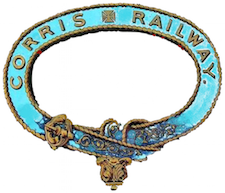
The Corris Railway is a narrow gauge preserved railway based in Corris on the border between Merionethshire and Montgomeryshire in Mid-Wales.

The Narrow Gauge Railway Museum is a purpose-built museum dedicated to narrow-gauge railways situated at the Tywyn Wharf station of the Talyllyn Railway in Tywyn, Gwynedd, Wales.

The Swanage Railway is a railway branch line from near Wareham, Dorset to Swanage, Dorset, England, opened in 1885 and now operated as a heritage railway.

The first railway in colonial South Australia was a horse-drawn tramway from the port of Goolwa on the Murray River to an ocean harbour at Port Elliot in 1854. Today the state has 1,600 mm broad gauge suburban railways in Adelaide, a number of country freight lines, as well as key 1,435 mm standard gauge links to other states.

There were more than a thousand British narrow-gauge railways ranging from large, historically significant common carriers to small, short-lived industrial railways. Many notable events in British railway history happened on narrow-gauge railways including the first use of steam locomotives, the first public railway and the first preserved railway.
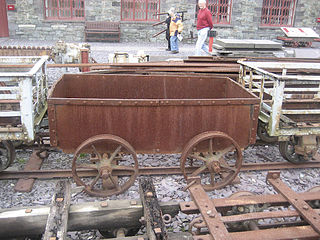
The Nantlle Railway was a Welsh narrow gauge railway. It was built to carry slate from several slate quarries across the Nantlle Valley to the harbour at Caernarfon for export by sea. The line provided a passenger service between Caernarfon and Talysarn from 1856 to 1865. It was the first public railway to be operated in North Wales.

Swanage railway station is a railway station located in Swanage, on the Isle of Purbeck in the English county of Dorset. Originally the terminus of a London and South Western Railway (L&SWR) branch line from Wareham, the line and station were closed by British Rail in 1972. It has since reopened as a station on the Swanage Railway, a heritage railway that currently runs from Norden station just north of Corfe Castle to Swanage station. It now also runs to Wareham on certain services, but not on regular services due to signalling problems.

Corfe Castle railway station is a railway station located in the village of Corfe Castle, in the English county of Dorset. Originally an intermediate station on the London and South Western Railway (L&SWR) branch line from Wareham to Swanage, the line and station were closed by British Rail in 1972. It has since reopened as a station on the Swanage Railway, a heritage railway that runs from Norden station just north of Corfe Castle to Swanage station, and as of 2018 South Western Railway operate summer Saturday services to Wareham, one of which continues to Salisbury via Weymouth and Yeovil.

Norden railway station is a railway station located one mile to the north of the village of Corfe Castle, on the Isle of Purbeck in the English county of Dorset. It is situated on the Swanage Railway, a heritage railway that operates over the former London and South Western Railway line from Wareham to Swanage. Norden is the northern terminus of the railway's steam service from Swanage, and an intermediate stop on the railway's diesel hauled service that connects Swanage with the national rail network at Wareham station.

The Sand Hutton Light Railway was a minimum gauge estate railway serving the estate of Sir Robert Walker, the Fourth Baronet of Sand Hutton, Yorkshire. It connected the main house with the LNER Warthill Station and the village of Bossall. It replaced the earlier, shorter, 15 in gauge Sand Hutton Miniature Railway that was built in 1914.
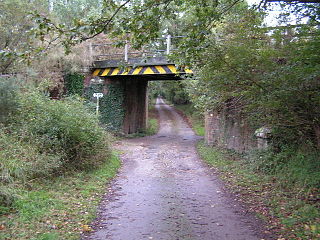
The Furzebrook Railway, also known as the Pike Brothers' Tramway, was a narrow gauge industrial railway on the Isle of Purbeck in the English county of Dorset. It was built by the Pike Brothers, to take Purbeck Ball Clay from their clay pits near Furzebrook and West Creech to a wharf at Ridge on the River Frome.
The Trefor Quarry railway was an industrial, 1 ft 11+1⁄2 in narrow gauge railway connecting the Trefor granite quarry with the pier at Llanaelhaearn on the Llŷn Peninsula.

Rail transport in Australia involves a number of narrow-gauge railways. In some states they formed the core statewide network, but in the others they were either a few government branch lines, or privately owned and operated branch lines, often for mining, logging or industrial use.
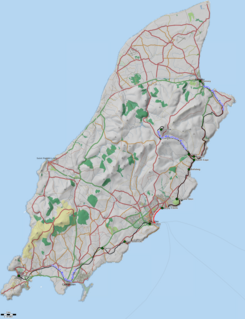
See also Transport in the Isle of Man.

The Haytor Granite Tramway was a tramway built to convey granite from Haytor Down, Dartmoor, Devon to the Stover Canal. It was very unusual in that the track was formed of granite sections, shaped to guide the wheels of horse-drawn wagons.
The Cedryn Quarry Tramway was an industrial narrow gauge railway that connected the slate quarries at Cedryn and Cwm Eigiau to the quays at Dolgarrog in the Conwy valley.

The Middlebere Plateway, or Middlebere Tramway, was a horse-drawn plateway on the Isle of Purbeck in the English county of Dorset. One of the first railways in southern England and the first in Dorset, the plateway was built by Benjamin Fayle, who was a wealthy Irish Merchant based in London and a friend of Thomas Byerley - Josiah Wedgwood's nephew. It was intended to take Purbeck Ball Clay from his pits near Corfe Castle to a wharf on Middlebere Creek in Poole Harbour, a distance of some 3.5 miles (5.6 km).

The Glenariff Iron Ore and Harbour Company (GIOH) was a railway and harbour company in Glenariff, County Antrim, in what is now Northern Ireland. It operated Red Bay Pier on the Antrim coast and about 4 miles (6.4 km) of narrow gauge railway between the pier and Cloughcor Mines in Glenariff. The railway was 3 ft narrow gauge and carried iron ore from the mines to the pier, where it was loaded onto cargo ships for export to ironworks in Scotland and England.
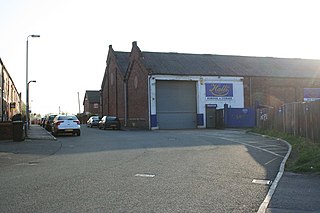
Wigan Corporation Tramways operated a tramway service in Wigan, England, between 1901 and 1931. The first tramway service in the town was run by the Wigan Tramways Company, whose horse trams began carrying passengers in 1880. They began replacing horses with steam tram locomotives from 1882, but the company failed in 1890 when a Receiver was appointed to manage it. The Wigan & District Tramways Company took over the system in 1893 and ran it until 1902. Meanwhile, Wigan Corporation were planning their own tramway system, obtaining an authorising Act of Parliament in 1893, and a second one in 1898. This enabled them to build electric tramways, and in 1902, they took over the lines of the Wigan & District Tramways Company.

The Purbeck Mineral and Mining Museum exists to preserve and interpret the historic extractive industries in ball clay mining in the Isle of Purbeck. The museum is located adjacent to Norden station on the Swanage Railway and is open from the end of March to the end of September on weekends, some weekdays and Bank Holidays.


















